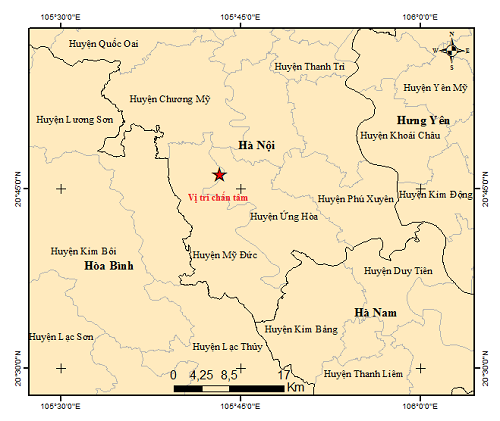On the morning of March 25, many people in some areas of Hanoi said they clearly felt the shaking caused by the aftershocks of the magnitude 4 earthquake that just occurred in My Duc district.

On the morning of March 25, people in some areas of My Duc district (Hanoi city) said they felt strong shaking, suspected to be aftershocks of the earthquake.
In some inner-city districts such as Cau Giay, Ha Dong, Thanh Xuan, people also clearly felt the shaking phenomenon occurring continuously 2-3 times.
Talking to reporters of VietnamPlus Electronic Newspaper about the above information, expert Nguyen Xuan Anh - Director of the Institute of Geophysics (Vietnam Academy of Science and Technology) said that the above shaking signs were caused by aftershocks of the 4-magnitude earthquake that recently occurred in My Duc district, Hanoi city.
According to expert Nguyen Xuan Anh, the earthquake occurred at 8:05 a.m. this morning, March 25. The depth of the earthquake's epicenter was about 16km.
The Director of the Institute of Geophysics also noted that normally earthquakes under 5 degrees are considered small earthquakes and rarely cause natural disaster risks.
Earthquakes of magnitude 5-6 or higher are moderate earthquakes, with a high risk of natural disasters. From 6 or higher are major earthquakes, with a very high risk of natural disasters.
According to regulations, when receiving news of an earthquake or tsunami warning, People's Committees at all levels must, by all means, notify the people in the area; organize evacuation instructions and mobilize local means to help people evacuate to a safe place; and ensure security and order in the area.
For the people, when receiving news of an earthquake or tsunami warning, all citizens in the affected area must proactively evacuate from the dangerous area to ensure safety.
Currently, the Earthquake Information and Tsunami Warning Center is still monitoring the development of the magnitude 4 earthquake in My Duc district, to promptly notify the mass media and local authorities.
In another development, sharing with reporters of VietnamPlus Electronic Newspaper, Associate Professor - Doctor Cao Dinh Trieu - Vice President of the Vietnam Association of Geophysics (Director of the Institute of Applied Geophysics) said that Hanoi is located in the Red River-Chay River fault zone, where earthquakes with magnitudes of 5.1-5.5 have occurred.
Normally, the recurrence cycle of 5.3 earthquakes in Hanoi city is 1,100 years and the last strong earthquake occurred more than 700 years ago (1285).
However, Mr. Trieu also noted that Hanoi is an area with poor soil, so there is a risk of a level 8 earthquake. The reason is that if an earthquake occurs in the Red River-Chay River fault zone (this earthquake zone passes through Hanoi) with the maximum data recorded by the monitoring station at level 6, the possibility of natural impacts can also reach level 8.
“Therefore, if an earthquake occurs in Hanoi, it will cause major tremors. If an earthquake of magnitude 4 or higher occurs, the old apartment buildings and old, degraded collective housing areas in the city will not be able to withstand it,” Mr. Trieu emphasized.
According to Mr. Trieu, in addition to the risk of major earthquakes, the Hanoi area is also an area with poor soil, so it is easy to feel tremors when there are major earthquakes elsewhere. In fact, in recent times, Hanoi has experienced tremors due to the influence of earthquake aftershocks from neighboring countries such as Laos and China.
Most recently, at around 8:43 p.m. on December 24, 2021, many people living in high-rise buildings in Hanoi felt strong shaking. The cause was later determined to be the impact of a 5.5 magnitude earthquake in Laos.
In addition to the aftershocks from overseas, in recent years, many localities across the country have also experienced a series of stimulating earthquakes. Historically, Vietnam has experienced an earthquake of magnitude 6.9 in the Dien Bien basin (in 1935). Therefore, according to Mr. Trieu, the impact of aftershocks from major earthquakes occurring in the country is also a potential risk.
From the above reality, Mr. Trieu believes that in the coming time, Vietnam in general and Hanoi in particular need to pay more attention to the issue of earthquake resistance for construction works, especially for civil works (such as high-rise apartments, etc.) to ensure safety as well as minimize potential risks that may occur and affect people.
“I think we need to focus on strengthening and re-establishing the network of earthquake monitoring stations in Hanoi. This is very important, because recently, every earthquake that has occurred in the distance has caused many buildings to shake, possibly because the foundations of buildings in Hanoi are a bit weak,” Mr. Trieu shared.
TN (according to Vietnam+)